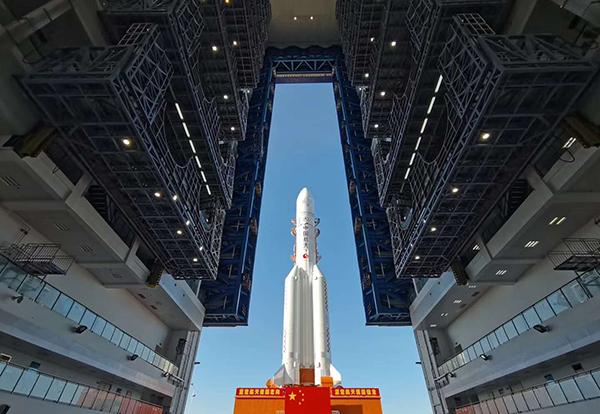
Image source: Zhang Gaoxiang, Press and Publicity Center of China National Space Administration, China Academy of Launch Vehicle Technology
The Paper learned from (www.thepaper.cn) that at 00:43 on December 30, the Long March 3B carrier rocket was ignited and launched at the Xichang Satellite Launch Center, successfully sending the communication technology test satellite No. 9 into the predetermined orbit, and the launch mission was a complete success. At this point, the 2021 space launch mission of China Aerospace Science and Technology Group Co., Ltd. has been successfully concluded.
According to the 2021 space launch plans of various countries, this mission is the last launch of global space this year. According to statistics, in 2021, a total of 144 space launches were carried out worldwide, breaking the record of 139 launches set in 1967. Among them, China has carried out 55 launches, ranking first in the world in the number of launches, and has also created a new record for the number of Chinese space launches.
According to manufacturer statistics, the United States conducted 51 space launches in 2021, Russia 25, ESA 6, Japan 3, India 2, Iran and South Korea 1 each.
Although just looking at the number of rocket launches does not represent too much, the new record at least reflects the rapid development of China's spaceflight, and this year's Chinese spaceflight has several major space missions that have attracted worldwide attention, such as multiple launches involving the space station.
On January 20, China successfully launched the Tiantong-1 03 satellite with the Long March 3B carrier rocket at the Xichang Satellite Launch Center, and the mission was a complete success, and China's space launch ushered in a good start in 2021.
The Successful Launch of the Tianhe Core Module, the opening of the curtain on the construction of the Chinese Space Station, the successful landing of Tianwen-1 on Mars, the Inspection and Exploration of the Zhurong Mars Rover, the twice in the sky of the Shenzhou spacecraft, the first spaceflight of female astronaut Wang Yaping, the number of Long March rocket launches exceeded 400 times, and the number of space launches hit a record high... In the upcoming 2021, the achievements of China's aerospace industry can be described as world-renowned, handing over a bright "report card".
In this "report card", the launch of the space station's core module and the landing of Tianwen-1 on Mars are undoubtedly the most watched annual space missions.
On April 29, the Long March 5B rocket carried the space station "Tianhe Core Module" and was launched at the Wenchang Cosmodrome in Hainan.
Space station is a kind of long-running in low Earth orbit, can meet the astronauts long-term in orbit life, work and ground astronauts to search for manned spacecraft, aerospace science and technology group five academies space station mission commander Wang Xiang previously pointed out, "As the largest spacecraft in human history, the space station represents the most comprehensive, most complex, most advanced and most comprehensive scientific and technological achievements in the field of space today, is one of the important embodiments of a country's space strength." ”
The core module is the core module of the space station, which plays the role of the core in the entire space station, and the launch mass of the Tianhe core module is 22.5 tons, which is the largest spacecraft currently developed in China. After the successful launch of the core module, the Tianzhou-2 cargo spacecraft and the Shenzhou-12 manned spacecraft have successively taken off, and Nie Haisheng, Liu Boming, and Tang Hongbo have been stationed in the core module for a period of 3 months, and during the orbit flight, two astronaut outgoing activities have been carried out, a series of space science experiments and technical experiments have been carried out, and the key technologies of space station construction and operation such as long-term astronaut stay, cabin departure activities, extravehicular operation, and on-orbit maintenance have been verified in orbit, laying a more solid foundation for the construction and operation of subsequent space stations.
On October 16, the Shenzhou spacecraft will go out again, and the Shenzhou 13 manned spacecraft will achieve multiple firsts: the first time with the three-cabin combination of autonomous and rapid radial rendezvous and docking; the first long-term orbital docking for 6 months; the first time with the emergency rescue capability of combining heaven and earth with multiple guarantees. Astronauts Zhai Zhigang, Wang Yaping, and Ye Guangfu will also refresh the 110-day orbital flight record just created by Nie Haisheng and others, creating a new Height for China.
In the field of deep space exploration, on May 15, the Tianwen-1 Mars probe successfully landed on the utopian plains of the northern hemisphere of Mars, and then the Zhurong rover successfully left the landing platform to begin a patrol exploration of Mars. Tianwen-1 completed the three-step "round-and-drop patrol" at one time, which is the first time in the world.
On December 10, the Long March series of carrier rockets ushered in the 400th launch, on the same day, the Long March 4B carrier rocket successfully sent the Shijian No. 6 05 group satellite into space. Of the 400 launches, the first three "100" took 37 years, 7 1/2 years and more than 4 years, respectively, while the latest "100" took only 2 years and 9 months from March 10, 2019 to the present.